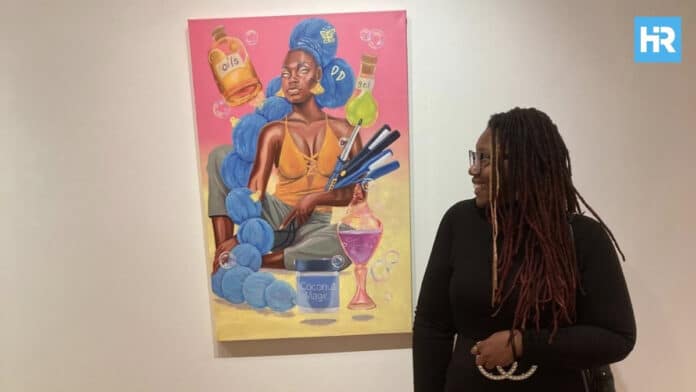Gallery 14C in Jersey City, New Jersey, is hosting the group exhibition Under the Influence from October 3, 2025, until January 11, 2026. Among the artists featured is April Cooper, a 40-year-old painter from Ewing who has established a strong presence in New Jersey’s arts community.
Her chosen work for the show, Invited to the Cookout, is a 36×48-inch oil painting that captures the vibrancy of a family cookout with food, music, and celebration. Cooper cites Ernie Barnes’ “Sugar Shack,” known from Good Times and Marvin Gaye’s I Want You album, as a direct inspiration for this piece.
- Ewing artist April Cooper will exhibit her oil painting, Invited to the Cookout, at Gallery 14C’s Under the Influence show in Jersey City, running from October 3, 2025, to January 11, 2026.
- Her widely recognized series Ghetto to Trendy explores how cultural styles once dismissed as “ghetto” later enter mainstream acceptance, drawing on themes of Black identity, pride, and appropriation.
- Cooper’s work, influenced by her Trenton roots, family heritage, and inspirations like Ernie Barnes’ “Sugar Shack,” has been featured in local New Jersey venues, Chicago’s Museum of Science and Industry, and international online exhibitions.
From Trenton Roots to the New Jersey Art Scene
Cooper was born in Trenton and began her schooling at Woodrow Wilson Elementary School before moving to Salisbury, Maryland. She went on to study both art and education at the University of Maryland Eastern Shore.
Her parents encouraged her artistic interests early on. Her father, Theron Charles, who is Antiguian, gave her a first easel, while her mother, Brenda Cooper-Matthews, who is African American, provided her first sketchbook. Family remains central to her practice today: her daughter Kamora, age 17, a student at Ewing High School, often appears in her paintings, and her sister Tyshea attends almost every festival and exhibition.
Recognition Through Local and National Exhibitions
Cooper’s first breakthrough came through Trenton’s Art All Night, a 24-hour festival that gave her confidence to pursue her art more consistently. Since then, she has exhibited at the Trenton City Museum, Passage Theatre, Artworks Trenton, and Slammin Brew.
Her work has also traveled further. She took part in the Black Creativity group exhibition at the Museum of Science and Industry in Chicago, a show that exposed her art to a large audience of young people. Online, she is featured in Biafarin’s international juried show “Food Story.”
Currently, her art is on view at Slamming Brew, Hub13, and Passage Theatre in Trenton. She was part of Art All Day at the New Jersey State Museum on September 20, 2025, and is showing at Artworks Trenton until October 11, 2025.
Her work can also be seen online at artbyaprilcooper.com and through her social media platforms: TikTok (@Aprilbydesign), Instagram (@artbyapril), Facebook (ArtbyAprilCooper), and YouTube (@artbyapril).
Themes of ‘Ghetto to Trendy’
One of Cooper’s best-known projects is the series Ghetto to Trendy. She describes the concept as an exploration of how styles and traditions that were once dismissed as “ghetto” later enter mainstream culture. Cornrows, for example, once ridiculed, are now widely accepted and legally supported under the CROWN Act.
In her own words, the series reflects “a celebration of Black culture; the moments, traditions, and symbols that shape our collective identity.” These include family practices such as seasoning food or cultural items like gold bamboo earrings. The project began with her personal reflections but grew into a wider dialogue, incorporating experiences shared by others.
Process, Materials, and Approach
Cooper primarily works from her home studio in Ewing, handling administrative tasks during the day and focusing on sketching and painting at night. She also works occasionally from Dunkin’ in Ewing or Slammin Brew in Trenton.
Oil paint is her preferred medium, a choice she traces back to watching Bob Ross at age 11. Although she experimented with watercolor and acrylic in school, she gravitated toward oils for their forgiving nature and capacity to support her creative vision.
Her method begins with sketches that outline her message clearly, including symbolic details such as gestures or expressions. Most works follow this initial plan, though at times the creative process introduces unplanned shifts that she incorporates into the final piece.






